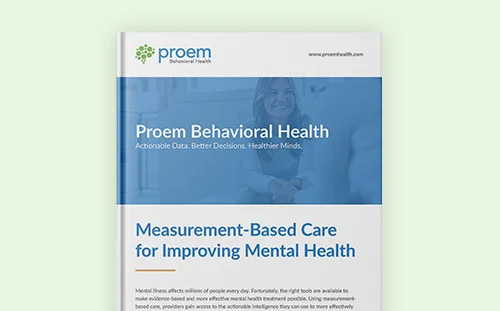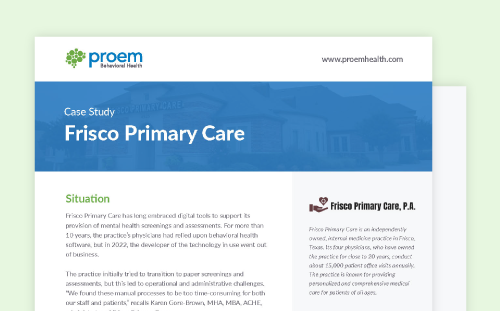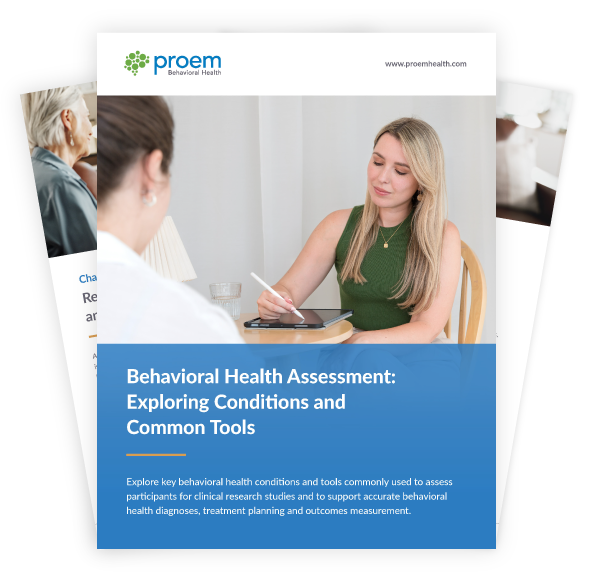Behavioral Health Assessment: Exploring Conditions and Common Tools
Behavioral health assessments play an invaluable role in identifying, diagnosing and treating mental health conditions. With structured tools and evidence-based methods, providers can better understand the challenges their patients face—whether it's obsessive-compulsive disorder (OCD), body dysmorphic disorder (BDD), or other behavioral health concerns.
This guide explores key behavioral health conditions and highlights commonly used tools to assess participants for clinical research studies and to support accurate behavioral health diagnoses, treatment planning and outcomes measurement.
Table of Contents
-
Chapter 1: Refining Behavioral Health Assessment and Diagnosis with the M.I.N.I.
-
Chapter 2: Behavioral Health Assessment and Function: Measuring Mental Illness’s Impact
-
Chapter 3: Demystifying OCD and Related Behavioral Health Assessment Methods
-
Chapter 4: Defining and Identifying BDD with Behavioral Health Assessments
-
Conclusion: Securing Fast Access to Digital Behavioral Health Assessment Tools

Chapter 1:
Refining Behavioral Health Assessment and Diagnosis with the M.I.N.I.
A critical tool for behavioral health assessment is the M.I.N.I., or the Mini International Neuropsychiatric Interview, which is a structured diagnostic interview that assesses the most diagnosed psychiatric disorders using criteria from the Diagnostic and Statistical Manual of Mental Disorders, 5th Edition (DSM-V).
What Is the Mini International Neuropsychiatric Interview Used For?
Developed by U.S. and European psychiatrists, the Mini International Neuropsychiatric Interview (M.I.N.I.) is a brief, structured tool that assesses mood, anxiety, psychotic, substance use and eating disorders. Designed for use in screenings, clinical trials, and epidemiological studies, it takes about 15 minutes to administer, with rapid results—especially when delivered electronically.
Its quick administration and standardized format make the M.I.N.I. especially valuable in research. It streamlines participant screening while minimizing bias and variability across populations, settings and cultures, helping ensure more reliable study outcomes.
What does the Mini International Neuropsychiatric Interview measure?
While measuring vitals like BMI or blood pressure is easy in physical medicine, diagnosing mental health conditions is more complex and subjective. The M.I.N.I. helps bridge this gap with a structured format that guides interviewers through targeted yes/no questions to efficiently rule out or identify specific disorders.
Organized into modules based on diagnostic criteria, the M.I.N.I. streamlines the process by examining patient emotions and experiences in a given timeframe and quickly flagging possible conditions. Though based on patient self-report, its design reduces unnecessary detours into unhelpful insights and improves consistency. Still, it’s a screening tool—not a replacement for a full psychological evaluation.
What age is the MINI Interview for?
The standard M.I.N.I. (PDF, online or paper) is designed to assess the most common diagnosed mental health disorders in patients 18 and older.
What is the Mini International Neuropsychiatric Interview for children?
The Mini International Neuropsychiatric Interview for children (“M.I.N.I.-KID” interview) assesses the most common diagnosed mental health conditions in children and adolescents, using the same format and administration as the standard M.I.N.I.
Has the efficacy of Mini International Neuropsychiatric Interview as an assessment tool been successfully validated?
Clinical researchers and healthcare providers should always ask whether an assessment tool is validated — and for the Mini International Neuropsychological Interview, the answer is yes. It has been widely validated across multiple studies and methods. A 1998 Journal of Clinical Psychiatry paper reported excellent interrater and strong retest reliability. Translated versions, like the Japanese M.I.N.I., have also shown high validity.
Is it possible to conduct the Mini International Neuropsychiatric Interview online?
Use of the Mini International Neuropsychiatric Interview (M.I.N.I.) requires a license. Proem Behavioral Health exclusively licenses digital, electronic, and PDF versions and is authorized to sublicense them. Proem also holds licensing rights for paper versions.
Proem also offers digital and PDF formats of the M.I.N.I. and M.I.N.I.-KID interviews to help improve participant identification and speed up recruitment for clinical trials—ultimately accelerating the development of neuropsychiatric treatments.
How Many Items Are in the Mini International Neuropsychiatric Interview?
The standard M.I.N.I. includes 17 modules aligned with DSM-V diagnoses, while the M.I.N.I.-KID interview (for ages 6–17) has 24 modules, including age-specific suicidality sections.
The number of questions per module varies based on responses. Negative answers can rule out a diagnosis quickly, while positive ones guide the interviewer to targeted follow-ups. Some modules, like substance use, include several brief items across multiple substance types.
Designed to be efficient, the M.I.N.I. asks only what's needed for a healthcare provider to make an accurate diagnosis or a clinical researcher to determine whether to include a subject in a study, helping streamline interviews and conserve research resources.
Since length varies by person, a common question is: “How long does the Mini International Neuropsychiatric Interview take?”
How Long Does It Take to Administer the DSM-V MINI?
The Journal of Clinical Psychiatry reports that administering the M.I.N.I. takes about 15 minutes, though actual times vary based on responses. A 2018 study found durations ranged from 12 to 60 minutes, with 83% completed in 30 minutes or less.
Digital administration is especially efficient, delivering results within seconds to avoid delays.
How to Score the Mini International Neuropsychiatric Interview
Mini International Neuropsychiatric Interview scoring is done by module, with each module tied to a specific suggested diagnosis and labeled by letter.
Each “yes” answer equals one point. Providers or researchers total the positive responses to see if the participant meets diagnostic criteria.
Research Applications of the MINI
The M.I.N.I. was designed with clinical research in mind, offering a brief document format to expedite participant evaluation and follow-up assessments.
Shorter than traditional tools but equally reliable, the M.I.N.I. saves time while achieving the same goals. The digital version delivers results in minutes, allowing research teams to assess more participants with fewer resources.
Consider three common scenarios.
1 Participant Recruitment: Screening and Consent
Using digital tools like the digital M.I.N.I., available through Proem, has been shown to improve recruitment rates and reduce onboarding time for ineligible participants. One study showed a 14% increase in participant sample size, while also identifying 21 wrongly included patients.
Patients and interviewers both benefit from the digital M.I.N.I. Most patients in a BMC Family Practice study were satisfied with the interview’s length and detail, with 96% feeling comfortable by the end.
One study showed a
14%
increase in participant sample size
2 Time-Sensitive Studies
The M.I.N.I.'s brevity makes it ideal for fast-moving studies. Longer assessments, like the Composite International Diagnostic Interview (CIDI), can take 92 minutes, which may delay recruitment. The M.I.N.I. takes a fraction of that time, allowing teams to screen up to four times as many applicants.
3 Longitudinal Studies
For large-scale longitudinal studies, the M.I.N.I. offers reliable and consistent tracking. Its straightforward structure makes it easier to monitor participant progress.
The digital M.I.N.I. further streamlines the process by allowing online interviews and quick follow-up coordination.
What Is the Difference Between SCID and MINI?
The Structured Clinical Interview for DSM-V (SCID-5) and the M.I.N.I. are both widely used diagnostic tools for identifying mental health disorders based on DSM-V criteria. Both follow a standardized approach to improve diagnostic accuracy and reliability.
However, there are key differences between the two that clinical researchers should be aware of:
-
Structure rigidity
-
Who can administer the interview
-
Complexity
-
Duration
-
Interviewee age ranges
Let's explore these differences further.
What is the purpose of a structured clinical interview?
Clinical interviews should be structured to collect and analyze data across various populations and settings, while minimizing risks from unconscious biases, cultural differences and other non-medical factors that could affect diagnosis.
While both the SCID-5 and M.I.N.I. are structured, the SCID-5 is more flexible. Administered by trained professionals, it serves as a "semi-structured interview guide," allowing the interviewer to add unscripted SCID-5 screening questions. In contrast, the M.I.N.I. is almost entirely scripted, “designed for rapid administration and intended to be overinclusive.”
How long does the SCID-5 take to administer?
It depends on the version used. The SCID-5 has three core versions for diagnosing DSM-V conditions and two for personality disorders. The core version (SCID-5-RV) typically takes 45–120 minutes, while others range from 30–180 minutes.
In contrast, the Mini International Neuropsychiatric Interview takes about 15 minutes.
What Is the SCID-5 scale? Is the SCID-5 reliable?
The SCID-5 comes in several versions to meet different needs:
-
SCID-5-RV: research
-
SCID-5-CV: provider
-
SCID-5-CT: clinical trials
-
SCID-5-PD: personality disorders
-
SCID-5-AMPD: alternative model for personality disorders
-
QuickSCID-5: brief version
Regarding reliability and validity, the American Psychiatric Association notes that there is no general reliability or validity data for the SCID-5, except for the NetSCID-5 online version. Research on specific versions, like the SCID-5-CV, has been conducted, such as a 2019 study on its reliability.
What about Mini International Neuropsychiatric Interview Reliability?
The Mini International Neuropsychiatric Interview, which has been validated several times using various methods, is widely used and accepted.
Are the SCID-5 and MINI appropriate for all age groups?
With some modifications to SCID-5 screening questions, the SCID-5 may be used for individuals under 18. The American Psychiatric Association says that while most SCID studies have been conducted with adults, some have successfully included adolescents. A version of the SCID-5 specifically for children and adolescents is in development.
In the meantime, the Mini International Neuropsychiatric Interview questionnaire has a validated version for children and adolescents, known as the M.I.N.I.-KID interview, which is widely used across various settings.
What other differences exist between the two tools?
While both the SCID-5 and the Mini International Neuropsychiatric Interview questionnaire are validated and widely used, the M.I.N.I. offers distinct advantages for clinical research where time is crucial.
The M.I.N.I. takes only 15 minutes to administer (compared to up to 180 minutes for the SCID-5), can be conducted by trained non-providers, and is easier to use in settings requiring large-scale screening, such as clinical trials. Studies have validated that the M.I.N.I. strikes a reasonable balance between brevity and accuracy compared to the SCID.
Why is the MINI so much faster and easier to use?
While a paper version of the M.I.N.I. is acceptable, its digital version, exclusively available through Proem Behavioral Health, offers several advantages. Researchers can obtain PDFs of the M.I.N.I. and M.I.N.I.-KID interview for easy distribution and use or license the M.I.N.I. for use on the Proem platform.
The digital version allows for online administration, broadening researchers' access to subjects who are geographically distant or unable to attend in-person interviews. Participants can complete the M.I.N.I. at their convenience, either independently or under supervision via video call, improving compliance and comfort.
Additionally, the digital M.I.N.I. streamlines data collection by automatically storing and aggregating responses, reducing scoring errors and speeding up the screening process.
Using the licensed digital version of the MINI
Proem is the only provider that holds a license for the digital version of the M.I.N.I., and using it saves time, improves efficiency, enhances data collection and reduces errors. It also helps you reach more study subjects while improving data quality and speeding up the process.

Chapter 2:
Behavioral Health Assessment and Function: Measuring Mental Illness’s Impact
In 2022, the National Institute of Mental Health estimated that about 23% of U.S. adults live with a mental illness. But while standard behavioral health assessment tools can support better care delivery and outcomes, many screening and assessment aids focus on symptom severity and miss how mental illness affects overall functioning.
Whole-person care emphasizes this broader impact, considering biological, social and environmental factors.
The Sheehan Disability Scale®(SDS) is a central cog in the whole-person care model. It evaluates how mental health conditions impair personal and professional functioning—supporting more holistic assessment of patients and study participants, as well as improved treatment planning and outcomes.
Sheehan Disability Scale: Gauging Mental Health’s Impact on Daily Life
The Sheehan Disability Scale examines three areas of impairment:
1 The Impact of Mental Health Disorders on Work or School Performance
Many people with mental health disorders struggle with focus, decision-making and task completion, impacting productivity and relationships at work or school. Missed days and poor performance can lead to isolation and financial stress.
The Sheehan Disability Scale helps assess how these issues affect a person’s ability to meet academic or job demands.
2 The Impact of Mental Health Disorders on Social Life
Mental health symptoms can disrupt emotional regulation, communication and connection, leading to isolation and strained relationships. Mood disorders may cause outbursts, while anxiety can lead to avoidance and loneliness.
The Sheehan Disability Scale measures how symptoms impact social life and relationships, helping tailor treatment to each person’s needs.
3 The Impact of Mental Health Disorders on Home Life
Mental health conditions can strain family relationships and household functioning. Cognitive issues may cause disorganization, while depression can create emotional distance and conflict. Financial stress from treatment costs may add further pressure.
The Sheehan Disability Scale helps identify home-life challenges and guide supportive solutions.
How the Sheehan Disability Scale Works
The SDS is one of the most straightforward mental health assessment tools, quantifying how symptoms affect daily life. Patients rate impairment in work/school, social, and home responsibilities on a 0–10 scale (no impairment to severe impairment).
The total score (0–30) offers a clear measure of functional disability, with higher scores indicating greater impact.
Using the Scale to Enhance Mental Health and Whole-Person Care
Using the SDS throughout treatment helps providers track patient progress and support whole-person care. It also informs clinical trials and treatment plans by revealing which interventions—medication, therapy, or lifestyle changes—drive meaningful improvement through pre- and post-treatment score comparisons.
Incorporate the SDS Into Your Practice
The Sheehan Disability Scale helps providers measure the real-world impact of mental health treatment. Through Proem, health care professionals and clinical researchers can license the SDS in digital and paper formats, as well as other mental health assessment tools, to assess the effects of mental health disorders more accurately.

Chapter 3:
Demystifying OCD and Related Behavioral Health Assessment Methods
Even in clinical circles, OCD is often misunderstood. It’s much more complicated and severe than mainstream media might have you believe, and trivializing it can prevent people from receiving the help they need.
Some healthcare professionals might not know that there are multiple types of OCD. Understanding this mental health condition and how it presents is critical to successfully diagnosing and treating patients, as is having the right approach to behavioral health assessment.
A Breakdown of the Condition and Types of OCD
OCD is characterized by recurring, unwanted thoughts (obsessions) and repetitive behaviors or mental acts (compulsions) that can profoundly interfere with daily life. It’s sometimes confused with Obsessive-Compulsive Personality Disorder (OCPD) and general anxiety. Let’s look at how these conditions differ from OCD.
OCD vs. Anxiety and OCPD
As the International OCD Foundation states, OCPD patients exhibit:
-
a broader pattern of perfectionism and control than OCD patients
-
persistent preoccupation with rules and order, vs. the distressing thoughts and repetitive behaviors involved in OCD
-
(frequently) a belief that their behaviors are rational and beneficial, which those with OCD don’t
OCD vs. anxiety:
-
Anxiety disorders overlap with OCD, particularly in how they manifest
-
However, they do not involve patterns of obsessions and compulsions
The 4 Types of OCD
The four primary kinds of OCD are:
1 Checking
What it involves: repeatedly checking things like locks and appliances to prevent perceived harm
Clinical Checking presentations:
-
Safety-Related – checking smoke detectors, emergency exits, etc., for possible hazards
-
Digital – checking digital communications for errors or inappropriate content
-
Memory-Based – reviewing interactions for mistakes or unintended harm
-
Physical/Medical – constantly monitoring vital signs, breathing or physical sensations (often leading to unnecessary medical visits)
-
Documentation – obsessively reviewing important documents, which lowers productivity
2 Contamination OCD
What it involves: deep fear of germs, dirt or toxins, leading to excessive cleaning or avoidance
Other fear centers:
Environmental Contamination
Concerns: radiation, asbestos, or electromagnetic fields
Resulting behaviors: avoidance of locations or technologies
Body
Concerns: bodily processes
Resulting behaviors: elaborate, detrimental cleaning rituals
Emotional
Concerns: "absorbing" negativity from others
Chemical
Concerns: everyday products
Resulting behaviors: extreme reactions often resulting in restricted diets or living spaces
3 Symmetry and Ordering
What it involves: compulsively arranging items to reduce discomfort or avoid perceived disaster
Patterns and what they require:
-
Mathematical Symmetry: Objects must be arranged in numerical patterns.
-
Visual Balance: Items align visually from multiple angles.
-
Time-Based Ordering: Activities are conducted in exact time intervals.
-
Sensory Symmetry: Both sides of the body have equivalent physical sensations.
-
Color-Based Arrangements: Items are organized by color patterns.
4 Intrusive Thoughts
What it involves: unrelenting, unwanted, and distressing thoughts that compel mental rituals to mitigate anxiety
Manifestations:
-
Moral Scrupulosity: obsession with moral righteousness and ethical perfection
-
Religious Scrupulosity: intrusive thoughts around religious inadequacy
-
Relationship OCD: recurring doubts about relationships
-
Harm OCD: intrusive thoughts about causing harm without intention
-
Existential OCD: obsessing about reality, existence and consciousness
Effective treatment for the different types of OCD may involve traditional practices like cognitive-behavioral therapy, or CBT (especially Exposure and Response Prevention); medication like selective serotonin reuptake inhibitors (SSRIs); environmental and lifestyle changes, such as creating more supportive home and work environments; and mobile symptom-tracking apps and virtual therapy sessions.
Assessment tools like the Yale-Brown Obsessive Compulsive Scale-II (YBOCS-II) and the Florida Obsessive-Compulsive Inventory (FOCI) are critical to evaluating the severity of OCD and tracking treatment progress.
YBOCS-II and FOCI: Understanding these Critical OCD Assessments
OCD assessment tools are important for many reasons: They help screen patients and research participants to identify different types of OCD, validate impressions against OCD diagnostic criteria, quantify condition severity, document symptom patterns, and track treatment progress. They also support care planning, patient education and engagement, and insurance authorization.
YBOCS-II: Detailed OCD Assessment
YBOCS-II gauges the severity and types of symptoms in an individual with OCD and offers a close look at their obsessive and compulsive behaviors. The assessment takes a trained healthcare professional about 30 minutes to complete and has two major components:
-
Checklist of obsessions and compulsions
-
Severity scale to assess the impact of symptoms on the patient's daily functioning, with scores ranging from 0 (no impact) to 40 (serious impact)
YBOCS-II scoring sums up individual items on the severity scale, so it clearly quantifies symptom severity. The tool has strong psychometric properties, such as high internal consistency and good test-retest reliability.
Younger patients are assessed with the Children's Yale-Brown Obsessive Compulsive Scale II (CYBOCS-II), which is tailored to children and adolescents but has a similar structure and purpose.
The YBOCS-II assessment takes a
trained healthcare professional about
30min
to complete
FOCI: Understanding This Essential Tool
The Florida Obsessive Compulsive Inventory (FOCI) OCD assessment is brief (taking 10 minutes) and easy to use. It identifies the presence and severity of OCD symptoms and is similarly structured to the YBOCS-II but with a streamlined symptom checklist and severity scale. (Scores range from 0 to 20.) It also has strong psychometric properties, including high internal consistency and strong validity.
The Children's Florida Obsessive Compulsive Inventory (C-FOCI) has a child-friendly format to identify and assess OCD in kids.
The choice between the YBOCS-II and FOCI OCD assessment tools may depend on the unique needs of the patient/participant and the clinical setting, with FOCI ideal for initial screenings but lacking depth of information, and YBOCS-II providing more thorough insights but not ideal for busy primary care offices.
Early Detection: Critical for Better Outcomes
Early detection of OCD helps improve outcomes by:
-
Preventing symptom escalation, which slows impairment in different areas of the patient’s life and offsets the risk of additional mental health conditions
-
Improving OCD’s impact on quality of life, such as daily functioning and relationships or the formation of deeply ingrained OCD patterns
-
Ensuring cost effectiveness, by reducing long-term health care costs, possible disability claims, intensive interventions and likely hospitalizations
The Evolution of OCD Screening: From Stigma to Science-Based Scales
Screening for and diagnosing OCD has come a long way, progressively shedding a brighter light on symptoms, reducing stigma and supporting more positive outcomes through better treatment. Initially, misconceptions about OCD made OCD screening difficult, with widespread confusion about impulsive vs intrusive thoughts contributing to misdiagnoses and delayed diagnosis and treatment. But with assessment tools, providers have gained significant ground.
The YBOCS Revolution
Emerging in the late 1980s, the Yale-Brown Obsessive Compulsive Scale (YBOCS) gave providers a structured approach to evaluating OCD symptoms and their severity. Known now as YBOCS-I, this OCD screening instrument was — at least for a time — the gold standard for OCD screening questions and symptom assessment.
Improvements in YBOCS-II changed the game for OCD diagnosis tests and symptom assessment with:
-
Expanded symptom categories and a dimensional approach, allowing for more targeted treatment and recognition of symptom heterogeneity across patient populations
-
A refined severity scale, with better anchor points for severity ratings, detection of small clinical changes, and differentiation between severity of obsessions and compulsions
-
Enhanced assessment of insight, so providers can better evaluate patient awareness and understanding of their condition and align with Diagnostic and Statistical Manual of Mental Disorders (DSM) criteria
-
Time management improvements, like streamlined administrative processes, more organized symptom checklists, and better flow within the tool
-
Clinical utility enhancements, such as assessment of functional impairment, improved integration with treatment plans, and better monitoring of treatment response
-
Research applications, including standardized symptom categories and sensitivity to treatment-induced changes
The Emergence of Self-Report
The YBOCS-II Self-Report version (YBOCS-II-SR) represents a major advancement in OCD screening by making the assessment process more accessible, efficient and patient-friendly. Designed to address practical limitations of the provider-administered version, the YBOCS-II-SR allows patients to complete screenings at their own pace, reducing anxiety and encouraging greater engagement. This self-directed approach not only empowers individuals but also helps reduce OCD stigma by fostering a more comfortable entry point into care.
For health care professionals and clinical researchers, the YBOCS-II-SR streamlines workflow by providing data before appointments, enabling more focused interviews and reducing administrative burden. Research supports its reliability for identifying symptoms, assessing severity and monitoring treatment response. Especially in primary care, the tool aids in distinguishing between intrusive vs. impulsive thoughts—helping providers make better-informed decisions about referrals. When integrated into the digital Proem Behavioral Health platform, the YBOCS-II-SR becomes a powerful, scalable tool that maintains clinical rigor while improving the overall efficiency of OCD assessment and care.
Impact on Clinical Practice
Over time, refinements to the YBOCS have greatly enhanced the accuracy and efficiency of OCD screening. Primary care providers and clinical researchers now have stronger tools for initial assessment, while behavioral health specialists can more effectively monitor treatment progress. Digital platforms further improve this process by offering streamlined administration, workflow integration, robust reporting, and evidence-based decision support.

Chapter 4:
Defining and Identifying BDD with Behavioral Health Assessments
Differentiating one mental health condition from another with behavioral health assessment tools can be surprisingly challenging when symptoms and presentations are similar. For example, body dysmorphia and eating disorders are sometimes confused and not taken as seriously as their effects warrant. Understanding what is BDD (Body Dysmorphic Disorder) and how its presence and symptoms are clinically assessed is crucial for providing effective, quality care for this condition.
What Is BDD? Defining Body Dysmorphic Disorder
Body Dysmorphic Disorder is a mental health condition marked by obsessive concern over perceived flaws in appearance. A well-known symptom of body dysmorphic disorder is excessive mirror checking or complete avoidance of mirrors, though the condition involves a broader range of behaviors.
Early signs often appear in adolescence and may include comparison of appearance with others, excessive grooming, frequent reassurance-seeking, reluctance to be photographed, and avoidance of social situations. These behaviors can significantly disrupt daily life and are often linked to concerns about facial features, body shape or hair. BDD frequently overlaps with body dysmorphia and eating disorders, and early recognition is key. A BDD test, such as the Body Dysmorphic Disorder Questionnaire (BDDQ), can help identify symptoms and guide further support.
The Relationship Between Body Dysmorphia and Eating Disorders
Body dysmorphia and eating disorders frequently occur together but are different conditions. While BDD centers on perceived flaws in specific physical features, it doesn’t focus solely on weight or body shape. Research shows that about 32% of individuals with BDD also experience an eating disorder at some point, highlighting the importance of screening for both when either is present.
Research shows that about
32%
of individuals with BDD also experience
an eating disorder at some point
Impact on Daily Life and Comorbidities
Recognizing which action is a well-known symptom of body dysmorphic disorder is critical to understanding its serious impact on daily life. Individuals with BDD may spend hours each day on appearance-related behaviors, experience major disruptions in work or school, and often develop depression or anxiety. The condition also carries a heightened risk of suicidal thoughts and behaviors, especially when combined with other mental health challenges or significant functional impairment.
When to Consider a BDD Test
Healthcare providers should consider a BDD test when patients show intense preoccupation with perceived physical flaws, often describing minor issues as severe and spending hours fixated on their appearance. Key warning signs include repetitive behaviors like mirror checking or camouflaging (e.g., wearing baggy clothing or excess makeup to cover "flaws”), significant distress or life disruption, and continuing dissatisfaction with their appearance even after reassurance or medical input.
Supporting Patients Through Recovery
BDD recovery requires a thorough approach, including:
-
Early detection, such as routine screenings for body image concerns, particularly in adolescents and those with anxiety or depression. Watch for signs like persistent dissatisfaction or seeking cosmetic procedures.
-
Accurate diagnosis, using structured tools like those licensed by Proem to assess BDD severity and comorbidities such as depression, anxiety, and eating disorders. Regular reassessment ensures appropriate care adjustments.
-
Evidence-based treatment that begins with cognitive behavioral therapy tailored for BDD (CBT-BDD) and SSRI prescriptions, starting at low doses. Incorporate exposure and response prevention and teach coping strategies for appearance-related distress.
-
Ongoing monitoring, using measurement-based care to track progress and standardized tools to quantify improvements and setbacks. Monitor symptoms, functioning, and overall quality of life. Proem offers a platform for effective tracking and outcomes measurement.
-
Care coordination, leveraging a network of mental health specialists for consistent support. Use collaborative care models and regular team check-ins to align treatment and improve outcomes.
An Overview of the Major BDD Assessment Tools & How to Implement Them
Accurate BDD assessment is essential, as the disorder is often misdiagnosed. Validated tools and structured interviews help ensure proper evaluation.
The Challenge of Accurate BDD Diagnosis
Diagnosing BDD without the right assessment tools is complex due to symptom overlap with other conditions like eating disorders, social anxiety and OCD. Patients often underreport symptoms out of shame, leading to delays in care. BDD can also present differently across ages, genders, and cultures, with adolescents expressing concerns via social media or grooming rituals, and adults struggling at work or in relationships.
Thoroughly assessing and then treating BDD can be further complicated by high comorbidity with related mental health disorders, which can cause providers to miss BDD symptoms, and time constraints in primary care offices that make comprehensive assessment difficult—underscoring the need for efficient screening tools and a structured clinical interview for DSM-5 protocols.
Available BDD Assessment Tools
There are several screening and assessment tools for BDD:
-
Body Dysmorphic Disorder Questionnaire (BDDQ): a quick, effective tool for initial BDD assessment. In under five minutes, it screens for core symptoms like appearance preoccupation and functional impairment, helping providers identify patients who need further evaluation.
-
BDD Diagnostic Module: a structured interview that guides providers through DSM-5-based questions on appearance concerns, behaviors, and life impact. Its format ensures consistent, thorough BDD evaluations across providers.
-
Body Dysmorphic Disorder Examination (BDDE): a semi-structured interview that explores appearance concerns, related behaviors, and their impact on daily life, while measuring degree of insight and resistance to BDD-related thoughts and behaviors.
-
BDD-YBOCS: a modified version of the Yale-Brown Obsessive Compulsive Scale that specifically targets BDD symptoms, measuring symptom severity, distress, and interference with daily life. It monitors treatment progress and clinical outcomes.
-
Brown Assessment of Beliefs Scale (BABS): an assessment of the strength of appearance-related beliefs and the level of insight patients hold related to those beliefs. It helps guide treatment planning and predict treatment response.
-
Body Dysmorphic Symptoms Scale (BDSS): a tool for identifying changes in BDD symptoms over the course of treatment, capturing emotional, behavioral, and functional aspects. It offers quantifiable data to guide treatment adjustments and measure progress.
-
Appearance Anxiety Inventory (AAI): a self-report tool that assesses appearance-related anxiety and avoidance, aiding in exposure and response prevention planning.
-
Body Image Depression Inventory (BIDI): a tool that assesses how body image concerns relate to depression, supporting integrated treatment for co-occurring conditions.
In addition to these screenings and assessments, health care professionals can also use clinical interview observation tools to document key clinical information about BDD in patients, such as:
-
Nature and intensity of appearance concerns
-
Impact on daily functioning
-
Family history and environmental factors
-
Previous treatment experiences
-
Current coping mechanisms
-
Risk assessment findings
Integration with Clinical Workflow
Digital BDD assessment tools allow for seamless integration of BDD assessment into existing clinical workflows. Using these tools through Proem offers several advantages:
-
Reduced administration time — Patients can complete digital assessments before visits, cutting assessment time by up to 40% and allowing providers to focus on care, not data collection.
-
Automatic scoring and interpretation — Results are scored instantly and accurately, reducing errors and saving time during appointments.
-
Standardized documentation — Digital formats ensure consistent, uniform records for symptom tracking, provider communication, and insurance support.
-
Streamlined progress tracking — Assessment results are stored electronically, making it simple to monitor symptom changes and generate reports. Digitization of records also allows health care professionals to more easily identify trends and patterns.
-
Enhanced diagnostic accuracy — Digital assessments ensure systematic evaluation of all diagnostic criteria, improving accuracy for complex conditions like BDD.
Patients can complete digital assessments
before visits, cutting assessment time by up to
40%
Using Clinical Interview Results to Inform Effective BDD Treatment
The initial BDD assessment or clinical interview is not only an indispensable tool for identifying and tracking BDD symptoms, but it also helps translate findings into personalized care—laying the foundation for effective, life-changing treatment by revealing each patient’s unique experience.
Implementing Assessment Tools Effectively
To get the most from BDD assessment tools, providers should use them consistently throughout treatment. Start with a comprehensive evaluation using multiple measures, then reassess regularly to track progress and guide adjustments.
When choosing tools, consider:
-
Time constraints and setting
-
Patient's cognitive and language abilities
-
Treatment goals
-
Documentation and insurance needs
-
Need for measurable outcomes
A standard protocol might include:
-
Initial assessment
-
Ongoing monitoring
-
Outcome tracking
-
Relapse prevention planning
Turning Insights into Action
Effective use of clinical interview findings supports more precise treatment planning, leading to better outcomes in cognitive behavioral therapy for BDD, improved medication choices, and co-occurring condition management. While real-world challenges like time and insurance limits can get in the way, comprehensive, evidence-based planning remains key to successful care.
Creating Personalized Treatment Approaches
Translating clinical interview findings into treatment plans involves multiple steps. Providers must first use the information to determine treatment intensity—severe cases may require intensive CBT for BDD and BDD medication, while milder cases may benefit from a lighter approach. Interview insights also guide precise choices of medications for BDD by revealing past medication experiences, side effect concerns, and daily routines.
To customize exposure and response prevention techniques to the patient, providers can utilize information the patient provides during the interview on what triggers their BDD symptoms to create a treatment framework that challenges the patient but maintains achievable goals.
Other BDD Treatment Considerations
Addressing Complex Needs
Co-occurring conditions often surface during clinical interviews, enabling integrated treatment approaches. For example, when BDD and eating disorders co-occur, providers can address both with combined therapies and targeted BDD medication.
Treatment Monitoring and Adjustment
Successful BDD treatment requires regular monitoring and flexibility. Ongoing check-ins help assess progress and guide adjustments—whether in therapy frequency, modification of medications for BDD or added support services.
Technology and Tools in Modern Treatment
Healthcare providers and clinical researchers now have advanced tools to improve BDD assessment. Digital tools like the Proem platform, featuring the BDDQ, treatment tracking software, and telehealth, support effective care delivery by recording clinical interview findings and monitoring progress over time.
The Role of Support Systems
The patient’s support system is central to effective BDD treatment. Clinical interviews reveal key insights on family and social dynamics, allowing providers to involve support figures effectively in the treatment plan.
Planning for Long-term Success
Long-term BDD treatment success relies on maintenance and relapse prevention. Clinical interview insights help identify triggers and guide strategies like continued CBT for BDD, maintenance medication protocols, and regular follow-ups.
A Path Forward
Achieving positive outcomes in BDD care starts with a thorough clinical interview and ends with a personalized, well-planned care strategy. Providers who carefully analyze interview findings and build tailored treatment plans see stronger results.
Proem supports this process with a complete suite of digital BDD assessment tools and resources.
Conclusion:
Securing Fast Access to Digital Behavioral Health Assessment Tools
The swift and accurate provision of behavioral health assessment tools is crucial to successfully diagnosing mental health conditions and delivering more personalized, effective treatment and better outcomes. Working with a partner that licenses all of these aids and can help you understand how to implement them is vital for any reputable health care provider or clinical researcher.
Proem offers many psychiatric assessments digitally and on our platform. Our tools and proprietary algorithms streamline testing for the presence of psychiatric conditions and help researchers simplify research workflows.
Contact us today to learn more or order individual tools.





.png)



